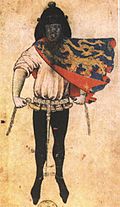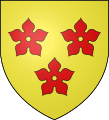Guelders facts for kids
Quick facts for kids
Duchy of Guelders
|
|||||||||
|---|---|---|---|---|---|---|---|---|---|
| 1096–1795 | |||||||||

Duchy of Guelders with Gelderland, about 1477
|
|||||||||
| Status | State of the Holy Roman Empire | ||||||||
| Capital | Geldern | ||||||||
| Government | Principality | ||||||||
| Historical era | Middle Ages, Renaissance | ||||||||
|
• Gerard I first
Count of Guelders |
1096 | ||||||||
|
• Raised to duchy
|
1339 | ||||||||
|
• Held by Jülich
|
1393-1423 | ||||||||
|
• Acquired by Burgundy
|
1473 | ||||||||
| 1581 | |||||||||
|
• Annexed by France
|
1795 | ||||||||
|
|||||||||
Guelders (also called Gueldres) was a historical region in Europe. It started as a county and later became a duchy. A duchy is a land ruled by a duke or duchess. Guelders was part of the Holy Roman Empire, which was a large group of lands in central Europe. It was located in the Low Countries, an area that today includes the Netherlands and Belgium.
Contents
Where was Guelders located?
The duchy got its name from the town of Geldern. This town is now in Germany. Most of the area that was once Guelders is now the province of Gelderland in the Netherlands.
However, the old duchy also included parts of:
- The present-day Dutch province of Limburg.
- Areas in the German state of North Rhine-Westphalia. These parts were taken over by Prussia in 1713.
The Four Quarters of Guelders
The Duchy of Guelders was divided into four main parts. Each part had its own important towns:
- The Overkwartier (Upper Quarter) or Quarter of Roermond. This area was along the Maas River. It included towns like Geldern, Erkelenz, Goch, Nieuwstadt, Venlo, and Straelen.
- The Quarter of Zutphen, also known as the Achterhoek. This part was east of the IJssel River and north of the Rhine River. Towns here included Doesburg, Doetinchem, Groenlo, and Lochem.
- The Quarter of Arnhem, also called the Veluwe. This area was west of the IJssel River and north of the Rhine. Important towns were Elburg, Harderwijk, Hattem, and Wageningen.
- The Quarter of Nijmegen, known as the Betuwe. This land was located between the Rhine and Maas rivers. It included towns like Gendt, Maasbommel, Tiel, and Zaltbommel.
A Brief History of Guelders
How did Guelders begin?
The first mention of Guelders as a county was around 1096. At that time, Gerard III of Wassenberg was recorded as the "Count of Guelders." The county was part of Lower Lorraine. Its main fort was at Montfort, built in 1260.
Gerard's son, Gerard II, gained the County of Zutphen in 1127 through marriage. Over the next two centuries, Guelders grew quickly along the Maas, Rhine, and IJssel rivers. It even tried to claim lands in the Duchy of Limburg. However, in 1288, Guelders lost the Battle of Worringen against its rivals.

Guelders often fought with its neighbors, like the County of Holland and the Bishopric of Utrecht. But it also grew peacefully. For example, William II, who was the count of Holland and Zeeland, gave Nijmegen to Guelders as a loan. When he couldn't pay back the money, Nijmegen became a permanent part of Guelders.
Becoming a Duchy and Losing Independence
In 1339, Count Reginald II of Guelders was made a duke by the Holy Roman Emperor Louis IV. This meant Guelders became a duchy. When Reginald died in 1371 without a child to inherit, William I of Jülich took over Guelders.
Later, in 1423, the House of Egmond family came to rule Guelders. Duke Adolf had a disagreement with his father, Arnold, about who should inherit the land. Arnold was pressured by Charles the Bold, the Duke of Burgundy, who put him in prison in 1471. When Arnold died in 1473, Duke Charles added Guelders to his Burgundian Netherlands.
The last independent Duke of Guelders was Charles of Egmond (1492-1538). He made the duchy even bigger by adding what is now the Province of Overijssel. Charles wanted Duke William the Rich to inherit Guelders. However, William couldn't keep it. Emperor Charles V of Habsburg soon took control. In 1543, Guelders finally lost its independence and became part of the Seventeen Provinces of the Habsburg Netherlands.
Guelders under Spain and the Dutch Revolt
In 1556, Emperor Charles V stepped down. He decided that the lands of the Burgundian Circle should belong to Spain. The northern parts of the Netherlands then rebelled against King Philip II of Spain. This led to the Dutch Revolt.
The three northern quarters of Guelders joined the Union of Utrecht. They became part of the United Provinces in 1581. Only the Upper Quarter of Guelders remained part of the Spanish Netherlands.
The Treaty of Utrecht in 1713 ended the War of the Spanish Succession. The Spanish Upper Quarter was then divided among several powers:
- Prussian Guelders (including Geldern, Viersen, Horst, Venray) went to Prussia.
- The United Provinces gained Venlo, Montfort, and Echt.
- Austria received Roermond, Niederkrüchten, and Weert.
- The Duchy of Jülich got Erkelenz.
Finally, in 1795, Guelders was conquered by the French First Republic. It was then divided into French departments called Roer and Meuse-Inférieure.
Coat of arms of Guelders
The symbol or coat of arms for the Guelders region changed over time.
See also
 In Spanish: Ducado de Güeldres para niños
In Spanish: Ducado de Güeldres para niños






